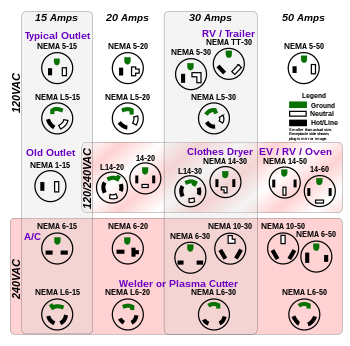So, I took some iphone photos and realized I can only upload them w/a URL, so let's do this the old fashioned way...
The plug looks like this:
L
\ /
So closest to the NEMA "10-30" in davewill's helpful picture. There is also some printing on the plug itself that reads "30A 125V/250V~" Feeling pretty confident at this point.
It was only slightly annoying to unplug the dryer cable...its behind the dryer but accessible (and I think we could scoot the dryer over a bit to make it easier). We probably do laundry once or twice a week, so it wouldn't necessarily be the end of the world to plug / unplug, and we often use a drying rack anyways. I definitely don't think I'd be qualified (in the "binder" sense of the word) to make the 3-way adapter, but I wouldn't rule out purchasing one for a fair price. I definitely would not run both at the same time though, we occasionally get flickering when our dryer is on and don't want to risk anything! Guessing it would also be a no-no to charge at 120v while drying?
We don't own the dryer, it came with the rental of the house, and it is brand new so doesn't make a ton of sense to replace it. I also don't want to make any permanent modifications to the property as its a rental and requires landlord approval under our lease.
Also, I heard a rumor that my employer may be putting in some fast chargers at our Menlo Park office...that would be pretty tempting! I could schedule my meetings there are the end of the day and pick up some charge on the way home


